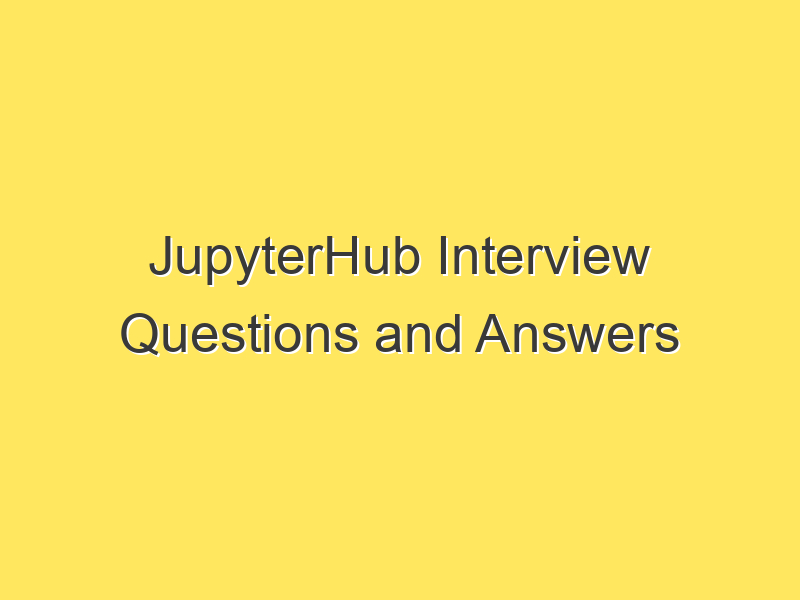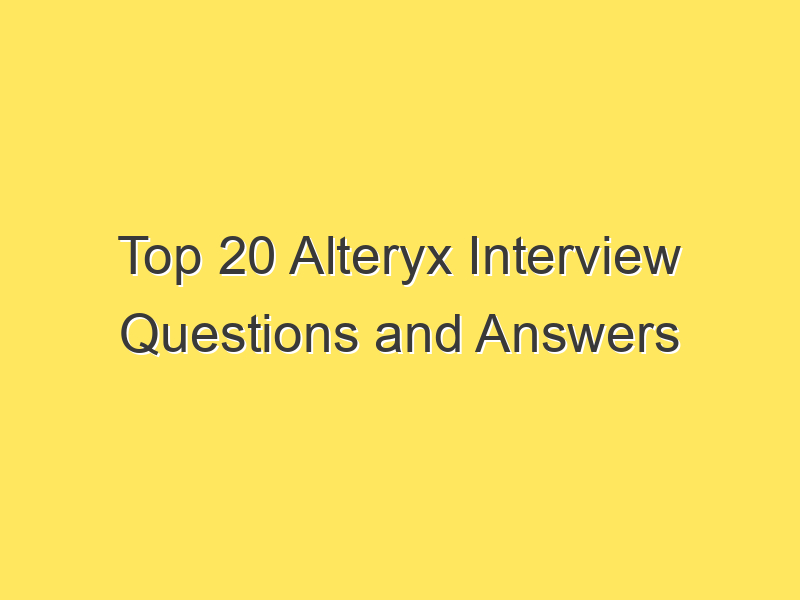Top 100 Alation Interview Questions and Answers: A Comprehensive Guide
If you’re preparing for an interview related to Alation, a leading data catalog platform, you’ll want to be well-prepared with knowledge and insights. Alation interviews often cover a range of topics, from data cataloging to data governance. To help you excel in your Alation interview, we’ve compiled a list of the top 100 interview questions along with detailed answers. Additionally, we’ve included some frequently asked questions (FAQs) about Alation interviews to provide you with a comprehensive guide.
Post Contents
Interview Questions and Answers:
1. What is Alation, and what is its primary purpose?
- Answer: Alation is a data catalog platform that helps organizations discover, understand, and manage their data assets efficiently.
2. How does Alation facilitate data discovery?
- Answer: Alation uses AI and machine learning to automatically catalog and index metadata, making data assets discoverable through a user-friendly interface.
3. What is data governance, and how does Alation support it?
- Answer: Data governance is the practice of managing and ensuring data quality, security, and compliance. Alation supports data governance by providing data lineage, data quality assessments, and policy enforcement.
4. Can you explain how Alation handles data lineage?
- Answer: Alation visualizes data lineage, showing how data flows through various systems, making it easier to understand data transformations and dependencies.
5. What are the key components of Alation’s data catalog?
- Answer: Alation’s data catalog includes data profiles, data lineage, data quality assessments, and collaboration features.
6. How does Alation ensure data quality?
- Answer: Alation offers data quality assessments that allow users to measure the quality of data assets based on various metrics.
7. What is the role of a data steward, and how does Alation assist data stewards?
- Answer: Data stewards are responsible for managing and maintaining data assets. Alation assists data stewards by providing tools for data profiling, data governance, and collaboration.
8. How does Alation handle data security and access control?
- Answer: Alation enforces access control policies, ensuring that users can only access data assets they are authorized to view.
9. Can you explain how Alation integrates with other data tools and platforms?
- Answer: Alation offers integrations with various data tools and platforms, allowing users to access and work with data from different sources seamlessly.
10. What is the significance of metadata, and how does Alation manage metadata? – Answer: Metadata is data about data, and Alation manages metadata by cataloging, indexing, and providing insights into the metadata of an organization’s data assets.
11. How does Alation handle data cataloging for unstructured data sources like documents? – Answer: Alation uses natural language processing (NLP) to catalog and extract metadata from unstructured data sources, making them searchable and understandable.
12. What are the benefits of using Alation’s data catalog for self-service analytics? – Answer: Alation’s data catalog empowers users to discover and understand data assets, reducing the time and effort required for data preparation and analysis.
13. How does Alation help with compliance and regulatory requirements like GDPR? – Answer: Alation provides features for data governance and policy enforcement, aiding organizations in meeting compliance and regulatory requirements.
14. Can you describe the collaboration features in Alation? – Answer: Alation offers collaboration features like data annotation, commenting, and sharing to facilitate communication and knowledge sharing among data users.
15. How does Alation assist in data asset discovery through its search capabilities? – Answer: Alation’s search capabilities include natural language search and metadata-driven search, making it easy for users to find relevant data assets.
16. What is Alation’s approach to data lineage visualization? – Answer: Alation provides an interactive and visual representation of data lineage, allowing users to explore data flows and dependencies.
17. How does Alation handle data catalog updates and maintenance? – Answer: Alation automates data catalog updates by continuously monitoring data sources for changes and updates.
18. Can you explain the role of data classification in Alation? – Answer: Data classification in Alation helps users identify sensitive or critical data, aiding in data governance and compliance efforts.
19. How does Alation handle data access for different user roles? – Answer: Alation offers role-based access control, ensuring that users have the appropriate permissions based on their roles and responsibilities.
20. What are the different deployment options for Alation? – Answer: Alation can be deployed on-premises or in the cloud, offering flexibility to organizations based on their infrastructure preferences.
21. How does Alation ensure data security in a cloud deployment? – Answer: Alation provides robust security measures, including encryption and access controls, to protect data in a cloud deployment.
22. What is the significance of data catalog automation, and how does Alation achieve it? – Answer: Data catalog automation in Alation reduces manual efforts in data cataloging by leveraging AI and machine learning to discover and catalog data assets.
23. Can you explain how Alation assists data analysts and data scientists in their work? – Answer: Alation helps data analysts and data scientists by providing a centralized platform for data discovery, data understanding, and collaboration.
24. How does Alation handle data quality issues and anomalies? – Answer: Alation identifies data quality issues through data profiling and allows users to address anomalies and discrepancies.
25. What is the role of data stewardship in data governance, and how does Alation streamline this process? – Answer: Data stewardship involves managing data assets, and Alation streamlines this process by providing tools for data profiling, data governance, and collaboration.
26. How does Alation enable users to contribute their knowledge and insights about data assets? – Answer: Alation allows users to annotate, comment on, and share their knowledge and insights about data assets, promoting collaboration and data understanding.
27. Can you describe Alation’s data profiling capabilities? – Answer: Alation’s data profiling capabilities provide insights into data quality, data structure, and data distribution, helping users understand data assets.
28. How does Alation assist in data asset documentation and metadata management? – Answer: Alation automates data asset documentation and metadata management, reducing manual efforts and ensuring consistency.
29. What role does data lineage play in data cataloging, and how does Alation visualize it? – Answer: Data lineage shows how data moves through an organization, and Alation visualizes it through interactive diagrams to help users trace data origins and transformations.
30. How does Alation help organizations improve data governance and compliance? – Answer: Alation offers data governance features such as policy enforcement, data classification, and audit trails, helping organizations adhere to governance and compliance standards.
31. Can you explain Alation’s data collaboration features? – Answer: Alation’s data collaboration features include data annotation, commenting, and sharing, fostering collaboration among users and teams.
32. How does Alation handle data cataloging for real-time or streaming data sources? – Answer: Alation can catalog real-time or streaming data sources by capturing metadata and providing insights into the structure and content of the data.
33. What are the key challenges that Alation addresses in the context of data cataloging? – Answer: Alation addresses challenges such as manual data discovery, lack of data understanding, and maintaining data quality by automating data cataloging processes.
34. Can you describe the process of implementing Alation in an organization? – Answer: Implementing Alation involves assessing data sources, configuring connectors, and setting up user roles and permissions. It also includes training users and monitoring system performance.
35. How does Alation integrate with business intelligence (BI) tools? – Answer: Alation integrates with BI tools, allowing users to seamlessly access and analyze data within their preferred BI environments.
36. What measures does Alation take to ensure the privacy of sensitive data? – Answer: Alation employs encryption, access controls, and data classification to ensure the privacy and security of sensitive data.
37. How does Alation handle data versioning and change tracking? – Answer: Alation tracks changes to data assets and provides versioning, allowing users to understand the evolution of data over time.
38. Can you explain the role of AI in Alation’s data cataloging process? – Answer: AI in Alation automates data discovery, metadata extraction, and data profiling, enhancing the efficiency and accuracy of data cataloging.
39. How does Alation assist in data cataloging for data lakes and big data environments? – Answer: Alation provides connectors and integrations for data lakes and big data platforms, enabling users to catalog and understand data stored in these environments.
40. How does Alation handle multi-cloud environments in terms of data cataloging? – Answer: Alation supports multi-cloud environments by providing connectors and integrations for data cataloging across various cloud platforms.
41. What are the key features of Alation’s data search functionality? – Answer: Alation’s data search includes natural language search, metadata-driven search, and advanced search filters, making it easy for users to find specific data assets.
42. How does Alation assist in data cataloging for data warehouses? – Answer: Alation offers connectors and integrations for popular data warehouses, allowing users to catalog and explore data stored in these platforms.
43. Can you explain Alation’s role in facilitating data democratization within an organization? – Answer: Alation promotes data democratization by providing a user-friendly data catalog that enables users across the organization to discover and understand data assets.
44. How does Alation handle data cataloging for structured and semi-structured data? – Answer: Alation uses metadata-driven approaches to catalog structured data and employs natural language processing (NLP) for semi-structured data, ensuring comprehensive data cataloging.
45. What reporting and analytics features does Alation provide within its platform? – Answer: Alation offers reporting and analytics features that allow users to gain insights into data usage, user activities, and overall data health.
46. How does Alation assist organizations in establishing a data-driven culture? – Answer: Alation supports a data-driven culture by providing tools for data discovery, understanding, and collaboration, fostering a culture where data is used strategically.
47. Can you explain Alation’s approach to metadata management and enrichment? – Answer: Alation automates metadata management by extracting and enriching metadata, ensuring that data assets are well-documented and understood.
48. How does Alation handle data cataloging for data virtualization environments? – Answer: Alation provides connectors for data virtualization platforms, allowing users to catalog and explore data in virtualized environments.
49. What strategies does Alation employ for data cataloging in a data lake architecture? – Answer: Alation employs automated discovery, metadata extraction, and data profiling strategies for cataloging data in a data lake architecture.
50. Can you explain Alation’s role in fostering collaboration among data users? – Answer: Alation fosters collaboration by providing features like data annotation, commenting, and sharing, enabling users to share insights and knowledge about data assets.
51. How does Alation handle data cataloging for real-time analytics use cases? – Answer: Alation can catalog data sources used in real-time analytics by capturing metadata and providing insights into the structure and content of real-time data.
52. How does Alation assist in data discovery for data scientists and advanced analytics users? – Answer: Alation assists data scientists by providing a centralized platform for discovering and understanding data assets, streamlining the data preparation process.
53. Can you describe Alation’s approach to automating the data cataloging process? – Answer: Alation uses AI and machine learning to automate data cataloging processes, reducing manual efforts and ensuring the catalog stays up-to-date.
54. How does Alation help organizations in maintaining data lineage for complex data architectures? – Answer: Alation visualizes data lineage for complex data architectures, providing a clear understanding of how data moves through different systems and processes.
55. What role does Alation play in enhancing data governance in a hybrid cloud environment? – Answer: Alation enhances data governance in hybrid cloud environments by providing consistent data cataloging and governance features across on-premises and cloud data sources.
56. How does Alation address challenges related to data silos within organizations? – Answer: Alation addresses data silos by providing a centralized data catalog that spans across different data sources, breaking down silos and promoting data collaboration.
57. Can you explain how Alation handles data cataloging for databases with diverse schemas? – Answer: Alation adapts to diverse database schemas by dynamically cataloging and documenting data assets, providing a unified view of the organization’s data.
58. How does Alation assist in metadata management for data lakes with large volumes of diverse data? – Answer: Alation automates metadata management for data lakes with large volumes of diverse data by using AI to extract and enrich metadata.
59. What considerations should organizations keep in mind when implementing Alation for data cataloging? – Answer: Organizations should consider assessing data sources, defining metadata standards, providing adequate training, and ensuring user adoption for a successful implementation of Alation.
60. How does Alation handle data cataloging for real-time data streaming platforms like Apache Kafka? – Answer: Alation can catalog data from real-time data streaming platforms by capturing metadata and providing insights into the structure and content of streaming data.
61. What is the role of Alation in data discovery and understanding for business analysts? – Answer: Alation plays a crucial role in data discovery and understanding for business analysts by providing a self-service data catalog that simplifies the process of finding and using data.
62. How does Alation assist organizations in building a data-driven decision-making culture? – Answer: Alation supports a data-driven decision-making culture by providing tools for data discovery, understanding, and collaboration, enabling informed decision-making based on data insights.
63. Can you explain how Alation ensures the accuracy and reliability of data catalog information? – Answer: Alation ensures accuracy and reliability by continuously monitoring data sources for changes and updates, ensuring that the catalog reflects the most recent information.
64. What role does Alation play in improving data literacy within an organization? – Answer: Alation improves data literacy by providing a user-friendly data catalog that empowers users to explore and understand data assets, regardless of their technical expertise.
65. How does Alation handle data cataloging for data stored in cloud-based data warehouses? – Answer: Alation offers connectors for cloud-based data warehouses, allowing users to catalog and explore data stored in platforms like Amazon Redshift, Google BigQuery, and Snowflake.
66. What features does Alation provide to support data cataloging for machine learning datasets? – Answer: Alation supports data cataloging for machine learning datasets by providing metadata-driven search, data profiling, and collaboration features for users working on ML projects.
67. How does Alation assist organizations in building a centralized and unified view of their data assets? – Answer: Alation helps organizations build a centralized and unified view by cataloging data from diverse sources, providing a single platform for users to discover and understand data assets.
68. Can you explain how Alation handles data cataloging for data lakes with a wide variety of file formats? – Answer: Alation handles diverse file formats in data lakes by using natural language processing (NLP) to understand and catalog unstructured and semi-structured data.
69. How does Alation address the challenge of data discovery in organizations with a large number of data sources? – Answer: Alation addresses this challenge by automating data discovery and cataloging, providing users with a centralized platform to search and explore data assets.
70. What steps should organizations take to ensure successful user adoption of Alation’s data catalog? – Answer: Organizations should provide comprehensive training, promote the benefits of using Alation, encourage collaboration, and address user feedback to ensure successful user adoption.
71. How does Alation support organizations in creating and enforcing data governance policies? – Answer: Alation supports data governance by providing features for data classification, policy enforcement, and audit trails, helping organizations create and enforce data governance policies.
72. Can you describe Alation’s role in improving data collaboration and knowledge sharing among teams? – Answer: Alation enhances data collaboration by providing features like data annotation, commenting, and sharing, facilitating knowledge sharing among teams and users.
73. How does Alation assist in data cataloging for organizations that use a combination of on-premises and cloud data storage? – Answer: Alation seamlessly catalogs data from both on-premises and cloud data storage, providing a unified view of data assets regardless of their storage location.
74. What measures does Alation take to ensure the scalability of its data cataloging solution? – Answer: Alation ensures scalability by using distributed architectures and optimizing performance, allowing organizations to scale their data catalog as their data environment grows.
75. How does Alation handle data cataloging for organizations with a mix of structured and unstructured data? – Answer: Alation uses a combination of metadata-driven cataloging for structured data and natural language processing (NLP) for unstructured data, ensuring comprehensive cataloging for diverse data types.
76. Can you explain how Alation facilitates data cataloging for organizations with multiple business units? – Answer: Alation allows organizations to create customized views and permissions for different business units, tailoring the data catalog to the specific needs of each unit.
77. How does Alation handle data cataloging for data stored in data lakes using the Apache Hadoop ecosystem? – Answer: Alation provides connectors for the Apache Hadoop ecosystem, allowing organizations to catalog and explore data stored in Hadoop-based data lakes.
78. What role does Alation play in ensuring the discoverability of data assets across an organization? – Answer: Alation enhances the discoverability of data assets by providing a centralized and searchable data catalog, making it easy for users to find relevant data regardless of its source.
79. How does Alation assist organizations in overcoming challenges related to data fragmentation and duplication? – Answer: Alation addresses data fragmentation and duplication by providing a centralized catalog that helps users discover and eliminate redundant data assets.
80. What role does Alation play in data cataloging for organizations with a diverse tech stack? – Answer: Alation adapts to diverse tech stacks by providing integrations and connectors for a wide range of data sources and platforms, ensuring comprehensive data cataloging.
81. Can you explain how Alation handles data cataloging for organizations with a mix of structured and semi-structured data? – Answer: Alation uses metadata-driven cataloging for structured data and natural language processing (NLP) for semi-structured data, offering a unified approach to cataloging diverse data types.
82. How does Alation assist in data cataloging for organizations that use a combination of cloud and on-premises data storage? – Answer: Alation seamlessly catalogs data from both cloud and on-premises storage, providing a unified view of data assets regardless of their storage location.
83. What is the significance of Alation’s collaboration features in promoting a data-driven culture within an organization? – Answer: Alation’s collaboration features foster a data-driven culture by facilitating communication, knowledge sharing, and collaboration among users, promoting a collective understanding of data.
84. How does Alation handle data cataloging for organizations with decentralized data management structures? – Answer: Alation provides customizable views and permissions, allowing organizations with decentralized data management structures to tailor the data catalog to the specific needs of different teams and units.
85. Can you explain how Alation supports data cataloging for organizations with a focus on data privacy and compliance? – Answer: Alation supports data privacy and compliance by providing features for data classification, access controls, and audit trails, helping organizations adhere to privacy and compliance standards.
86. How does Alation assist organizations in maintaining a consistent and accurate data catalog over time? – Answer: Alation automates data catalog updates by continuously monitoring data sources for changes, ensuring that the catalog remains consistent and accurate over time.
87. Can you describe Alation’s approach to handling data cataloging for organizations with complex data architectures? – Answer: Alation visualizes data lineage for complex data architectures, providing users with a clear understanding of how data moves through different systems and processes.
88. How does Alation handle data cataloging for organizations that use a combination of traditional databases and modern data platforms? – Answer: Alation provides connectors and integrations for both traditional databases and modern data platforms, offering a unified view of data assets across diverse systems.
89. What measures does Alation take to ensure the security of sensitive data within its data catalog? – Answer: Alation employs encryption, access controls, and data classification to ensure the security of sensitive data within its data catalog.
90. How does Alation handle data cataloging for organizations with a large volume of data assets? – Answer: Alation uses scalable and distributed architectures to handle large volumes of data assets, ensuring optimal performance and responsiveness even in environments with a vast amount of data.
91. What role does Alation play in improving data collaboration among business users, IT teams, and data scientists? – Answer: Alation fosters collaboration by providing a common platform for business users, IT teams, and data scientists to discover, understand, and share insights about data assets.
92. Can you explain Alation’s role in simplifying the process of data discovery and analysis for business users? – Answer: Alation simplifies data discovery and analysis for business users by providing a user-friendly data catalog with search capabilities, making it easy to find and use relevant data.
93. How does Alation assist organizations in building a knowledge base of best practices for data usage and analysis? – Answer: Alation supports the creation of a knowledge base by allowing users to annotate, comment on, and share insights about data assets, creating a repository of best practices for data usage and analysis.
94. Can you describe Alation’s role in facilitating data cataloging for organizations with data stored in distributed environments? – Answer: Alation supports data cataloging for distributed environments by providing connectors and integrations for data stored in various distributed systems.
95. How does Alation handle data cataloging for organizations with a diverse range of data consumers, from business analysts to data scientists? – Answer: Alation caters to diverse data consumers by providing a user-friendly interface and features that meet the needs of business analysts, IT teams, data scientists, and other users.
96. What role does Alation play in improving the efficiency of data analysts and data scientists in their work? – Answer: Alation improves efficiency by providing a centralized platform for data discovery, understanding, and collaboration, streamlining the workflow of data analysts and data scientists.
97. How does Alation handle data cataloging for organizations with multiple data cataloging tools and platforms? – Answer: Alation can integrate with multiple data cataloging tools and platforms, providing a unified view of data assets even in organizations with diverse cataloging tools.
98. Can you explain how Alation supports organizations in creating a culture of continuous improvement in data management? – Answer: Alation supports continuous improvement by providing tools for data governance, collaboration, and knowledge sharing, enabling organizations to iteratively enhance their data management practices.
99. How does Alation assist in data cataloging for organizations that use a variety of data integration and ETL tools? – Answer: Alation integrates with data integration and ETL tools, allowing users to catalog and understand data that has undergone various transformations.
100. What role does Alation play in promoting data literacy and education within an organization? – Answer: Alation promotes data literacy by providing a user-friendly data catalog that encourages exploration and understanding of data, contributing to the education and empowerment of users across the organization.
Frequently Asked Questions (FAQs):
Q1: What is the significance of a data catalog in an organization?
- Answer: A data catalog plays a crucial role in an organization by providing a centralized and searchable repository of data assets. It enhances data discovery, understanding, and collaboration, ultimately supporting informed decision-making.
Q2: How does Alation contribute to data governance?
- Answer: Alation contributes to data governance by providing features for data classification, policy enforcement, and audit trails. It helps organizations manage data quality, security, and compliance.
Q3: Can Alation handle data cataloging for both structured and unstructured data?
- Answer: Yes, Alation can handle both structured and unstructured data. It uses metadata-driven approaches for structured data and employs natural language processing (NLP) for unstructured data.
Q4: What steps should organizations take to ensure successful user adoption of Alation’s data catalog?
- Answer: Successful user adoption requires comprehensive training, promotion of benefits, encouragement of collaboration, and addressing user feedback. Organizations should create awareness about the value of using Alation.
Q5: How does Alation ensure the security of sensitive data within its data catalog?
- Answer: Alation ensures the security of sensitive data through encryption, access controls, and data classification. These measures protect sensitive information and help organizations adhere to privacy standards.
Q6: What role does Alation play in promoting a data-driven culture within an organization?
- Answer: Alation promotes a data-driven culture by providing tools for data discovery, understanding, and collaboration. It fosters a culture where data is used strategically to drive decision-making.
Q7: How does Alation assist organizations in overcoming challenges related to data fragmentation and duplication?
- Answer: Alation addresses data fragmentation and duplication by providing a centralized catalog. This helps users discover and eliminate redundant data assets, promoting data consistency.
Q8: What considerations should organizations keep in mind when implementing Alation for data cataloging?
- Answer: Organizations should consider assessing data sources, defining metadata standards, providing training, and ensuring user adoption. These considerations are crucial for a successful implementation of Alation.
Q9: How does Alation handle data cataloging for organizations with a large volume of data assets?
- Answer: Alation ensures scalability by using distributed architectures and optimizing performance. This allows organizations to handle large volumes of data assets effectively.
Q10: What is the role of Alation in improving data collaboration among business users, IT teams, and data scientists?
- Answer: Alation plays a crucial role in improving data collaboration by providing a common platform for different teams to discover, understand, and share insights about data assets.
In conclusion, Alation’s data cataloging platform is a powerful tool that enhances data management, governance, and collaboration within organizations. As organizations increasingly recognize the importance of leveraging data for strategic decision-making, solutions like Alation play a pivotal role in ensuring that data is not only accessible but also well-understood and effectively governed. By addressing a wide range of data cataloging challenges and providing robust features, Alation contributes significantly to creating a data-driven and informed organizational culture.






